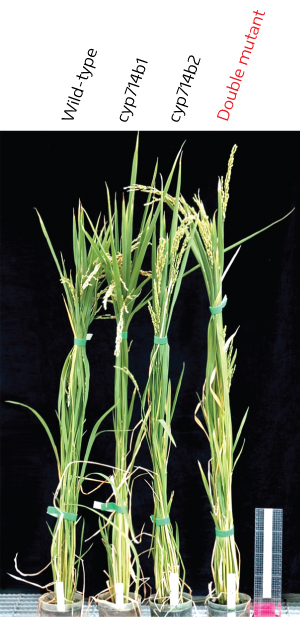May 2, 2013 Research Highlight Biology
Fine-tuning plant growth
Finding the missing genes in a hormone-biosynthesis pathway hints at subtle control of growth in rice
 Figure 1: Mutant rice plants without the CYP714B1 and CYP714B2 genes (right) show enhanced uppermost node lengths, indicating that these genes are negative regulators of growth. Reproduced from Ref. 1 © 2013 H. Magome et al.
Figure 1: Mutant rice plants without the CYP714B1 and CYP714B2 genes (right) show enhanced uppermost node lengths, indicating that these genes are negative regulators of growth. Reproduced from Ref. 1 © 2013 H. Magome et al.
The plant hormones known as gibberellins (GAs) are growth promoters that are involved in a wide range of processes from seed germination to flower development. The details of the biosynthesis of GAs, however, have yet to be fully clarified. Hiroshi Magome and colleagues of the Gene Discovery Research Group at the RIKEN Center for Sustainable Resource Science have now identified genes for two ‘cytochrome P450’ enzymes involved in GA biosynthesis in rice1.
Magome’s team found that mutant rice plants without the CYP714B1 and CYP714B2 genes had lengthened uppermost internodes (Fig. 1), indicating that these two genes are negative regulators of growth. Overexpression of these genes in Arabidopsis, on the other hand, resulted in semi-dwarf plants.
Certain carbon atoms in GA molecules may be linked to either a hydrogen (H) or hydroxyl group (OH). At the 13th carbon, the ratio between these forms is determined by GA 13-oxidase enzymes, which hydroxylate the –H group to an –OH. CYP714B1 and CYP714B2 are the first GA 13-oxidase genes to be characterized, and represent a key missing link in the GA-biosynthesis pathway.
In rice mutants without the CYP714B1 and CYP714B2 genes, levels of 13-OH GAs were reduced and 13-H GAs were increased, indicating that these two genes have a major role in GA 13-hydroxylation in rice. The researchers also found that exogenous application of bioactive GAs up-regulates expression of both genes, representing evidence of a homeostatic mechanism regulating GA levels in rice.
Functional analyses applying recombinant CYP714B1 and CYP714B2 proteins to a variety of GA substrates enabled the team to identify the very step in GA synthesis at which the proteins act: hydroxylation of GA12 to form GA53. In flowering plants, GA12 is a forerunner of GA4, a highly bioactive GA, while GA53 is a precursor of GA1, which is only weakly active. Growth repression by CYP714B1 and CYP714B2 is therefore caused by hydroxylation of GA12 resulting, downstream, in the production of a less-active GA.
In rice, the weakly active GA1 is the predominant form of GA in most tissues. Magome suggests that this counterintuitive observation might indicate tight regulation of growth through minute modifications in weakly active GAs, in addition to the dramatic changes facilitated by the more active GA4. This combined approach could allow plants to fine-tune their growth to suit their circumstances. Moderate suppression of plant growth, as provided by CYP714B1 and CYP714B2, is also associated with improved crop yields. “Our findings show promise for the development of new plant growth control technologies,” says Magome.
References
- 1. Magome, H., Nomura, T., Hanada, A., Takeda-Kamiya, N., Ohnishi, T., Shinma, Y., Katsumata, T., Kawaide, H., Kamiya, Y. & Yamaguchi, S. CYP714B1 and CYP714B2 encode gibberellin 13-oxidases that reduce gibberellin activity in rice. Proceedings of the National Academy of Sciences USA 110, 1947–1952 (2013). doi: 10.1073/pnas.1215788110
